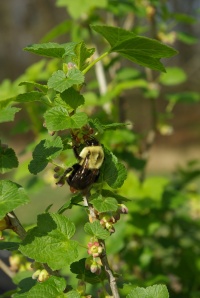
CROP DESCRIPTION:

There are several species of black currant but the one we’re primarily focused on is Ribes nigrum, the European black currant which grows indigenous to central and northern Europe and northern Asia (2). The plants grow as a medium sized shrub reaching 3-6′ in height and width. Black currants are hardy to at least zone 3. The inconspicuous flowers are born in long racemes and appear to be primarily insect pollinated. Bumbles bees love black currant flowers. Frost damage is a common threat and different cultivars exhibit varying degrees of frost resistance. The fruits hang in strigs which ripen in late June through early August depending on the variety. They’re rich and unique flavor is sought after by many for the delectable jams, jellies, and juices they make. Black currant also has an outstanding nutraceutical profile with high levels vitamin C, antioxidants, anthocyanins, and other phytochemicals. Fruiting occurs mainly from first and second year wood. Annual pruning is necessary to maintain vigor and productivity. Black currants respond and take readily to vegetative propagation via hardwood cuttings and layering. As a crop they’re not all that finicky about soil preferences and are adapted to a wide range of conditions. They thrive in soils which are consistently moist but not waterlogged. They do not tolerate drought and scorching conditions and in the south are typically planted in partial shade to avoid that. Unlike most fruit crops currants and gooseberries can both thrive and produce in partial shade. Wide adaption hints at the crop potential and versatility of not only black currant but the rest of the Ribes clan as well. However, there are a few diseases which pose challenges to black currant cultivation. Reversion disease is a virus transmitted by the gall mite which can weaken and stress black currant bushes; fortunately this is uncommon in the Midwest. Powdery mildew, although more prominent amongst gooseberries, will decimate the health of non-resistant black currant cultivars…many of the old European varieties are particularly prone to mildew. Last but certainly not least— black currant is an alternate host for white pine blister rust which is a disease that can devastate native white pine populations but causes little harm to the black currant plant itself.
CROP HISTORY & BREEDING POTENTIAL:
There is a long history of growing black currants in Russia and they’ve been cultivated for centuries throughout central and northern Europe (4). Black currants found there way to North America with the early settlers where they became a common crop throughout the 18th and 19th century. It was in the early 1900’s that a federal ban was placed on black currant cultivation in an attempt to combat white pine blister rust and limit it’s damaging effects on the logging industry. It was around this time that currants fell out of popularity as both a garden and farm crop. In 1966 the federal ban was lifted to state jurisdiction making black currant cultivation viable once again. Since then several states have removed the regulations altogether while others still have bans. A permit is required to obtain black currant plants in some parts of Michigan. Check with your local regulations. In the 1930’s a Canadian breeding program was initiated to develop rust resistant cutlivars by crossing R. nigrum with the naturally resistant R. ussuriense. ‘Consort’, ‘Crusader’, and ‘Coronet’ all came from this breeding project. Numerous rust resistant varieties have been released in the past several decades like the Swedish cultivar, ‘Titania’, and the Russian cultivar, ‘Minaj smyriou’ (1). The Scottish Research Institute developed the Ben series with increased hardiness and disease resistance in mind. The climate and growing conditions of the Midwest are often times ideal for currants. The three main varietal selection criteria for the Midwest are:
- White pine blister rust resistance
- Mildew resistance
- Frost hardiness in flowers
CULTIVARS:
| Consort |
| Titania |
| Crusader |
| Ben Sarek |
| Blackdown |
| Minaj Smirou |
| Belaruskaja |
| Vertti |
| Storklas |
| Kirovchanka |

RERENCES:
1. Barney, Danny L., and Kim E. Hummer. Currants, Gooseberries, and Jostaberries: A Guide for Growers, Marketers, and Researchers in North America. New York: Food Products, 2005. Print.
2. Reich, Lee, and Lee Reich. Uncommon Fruits for Every Garden. Portland: Timber, 2004. Print.
3. Card, Fred W. Bush-fruits; a Horticultural Monograph of Raspberries, Blackberries, Dewberries, Currants, Gooseberries, and Other Shrub-like Fruits. New York: Macmillan, 1898. Print.
4. “Black Currant.” Wikipedia. Wikimedia Foundation, 28 Feb. 2014. Web. 02 Mar. 2014.
5. “Cronartium Ribicola, White Pine Blister Rust.” Wikipedia. Wikimedia Foundation, 23 Feb. 2014. Web. 02 Mar. 2014.
